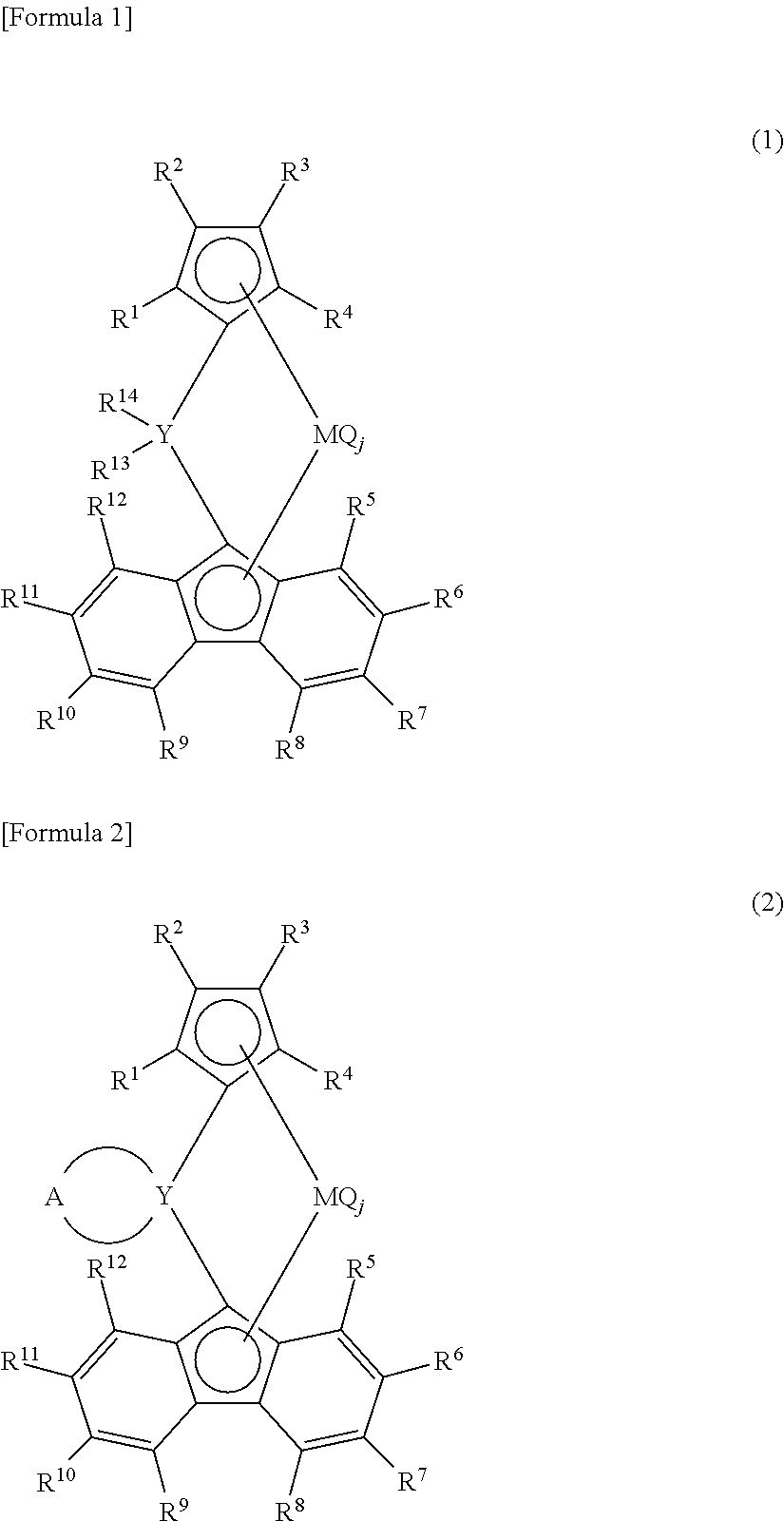4-METHYL-1-PENTENE/a-OLEFIN COPOLYMER, COMPOSITION COMPRISING THE COPOLYMER AND 4-METHYL-1-PENTENE COPOLYMER COMPOSITION
a technology of a-olefin and copolymer, which is applied in the field of 4-methyl-1 pentene/a-olefin copolymer, a composition comprising the copolymer, can solve the problems of low stereoregularity polymer or low-molecular weight polymer, adverse influence as a sticky component, and reduce mechanical properties such as toughness and strength, and achieves the effect of flexibleness, toughness, and preferable mechanical properties
- Summary
- Abstract
- Description
- Claims
- Application Information
AI Technical Summary
Benefits of technology
Problems solved by technology
Method used
Image
Examples
example 1
[0489]Into a SUS autoclave with an agitating element having a volume of 1.5 L that had been sufficiently purged with nitrogen, at 23° C., 750 mL of 4-methyl-1-pentene was introduced. Into this autoclave, 0.75 mL of a toluene solution of 1.0 mmol / mL of triisobutylaluminum (TIBA1) was introduced, and the agitator was operated. Then, the autoclave was heated till the temperature of the mixture became 30° C., and pressurization using propylene was performed such that the total pressure became 0.74 MPaG. Then, 0.34 mL of a previously-prepared toluene solution containing 1 mmol in terms of Al of methylaluminoxane and 0.005 mmol of diphenylmethylene (1-ethyl-3-t-butyl-cyclopentadienyl) (2,7-di-t-butyl-fluorenyl)zirconiumdichloride was injected using nitrogen into the autoclave, thereby initiating polymerization. For the following 60 minutes, temperature of the autoclave was controlled such that the temperature of the mixture was 60° C. At 60 minutes past the initiation of the polymerizatio...
example 2
[0491]Into a SUS autoclave with an agitating element having a volume of 1.5 L that had been sufficiently purged with nitrogen, at 23° C., 750 mL of 4-methyl-1-pentene (4 MP1) was introduced. Into this autoclave, 0.75 mL of a toluene solution of 1.0 mmol / mL of triisobutylaluminum (TIBA1) was introduced, and the agitator was operated. Then, the autoclave was heated till the temperature of the mixture became 30° C., and pressurization using propylene was performed such that the total pressure became 0.68 MPaG. Then, 0.34 mL of a previously-prepared toluene solution containing 1 mmol in terms of Al of methylaluminoxane and 0.005 mmol of diphenylmethylene (1-methyl-3-t-butyl-cyclopentadienyl)(2,7-di-t-butyl-fluorenyl)zirconiumdichloride was injected using nitrogen into the autoclave, thereby initiating polymerization. For the following 60 minutes, temperature of the autoclave was controlled such that the temperature of the mixture was 60° C. At 60 minutes past the initiation of the polym...
example 3
[0493]Polymerization was performed in the same manner as in Example 2, except that the pressurization using propylene was performed such that the total pressure in the polymerization container was 0.35 MPaG.
[0494]The resultant polymer weighed 46.9 g, and the content of propylene in the polymer was 52.7 mol %. With regard to the polymer, Tm was not observed; the intrinsic viscosity [η] was 1.41 dL / g; the molecular weight distribution obtained by GPC was such that Mw was 285000, Mn was 143000, and Mw / Mn was 2.0; the extracted amount under methyl acetate was 0.2 wt %; YM was 3 MPa; ΔHS was 38; and the maximum value of tan δ was 3.4 (temperature giving the maximum value: 19° C.). Properties of the resultant polymer are shown in Table 1.
PUM
 Login to View More
Login to View More Abstract
Description
Claims
Application Information
 Login to View More
Login to View More - R&D
- Intellectual Property
- Life Sciences
- Materials
- Tech Scout
- Unparalleled Data Quality
- Higher Quality Content
- 60% Fewer Hallucinations
Browse by: Latest US Patents, China's latest patents, Technical Efficacy Thesaurus, Application Domain, Technology Topic, Popular Technical Reports.
© 2025 PatSnap. All rights reserved.Legal|Privacy policy|Modern Slavery Act Transparency Statement|Sitemap|About US| Contact US: help@patsnap.com

